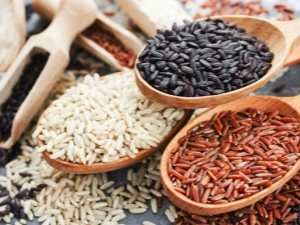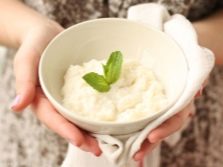Diabetes rice: is it possible to eat and how does it affect health?

Diabetes mellitus is one of the most common diseases of our time, because, according to experts, up to 10% of the population of our planet suffer from it. The patient's body is not able to independently control the level of sugar in the blood, because this task falls entirely on the shoulders of a conscious patient who must constantly adhere to a strict diet and keep medicines on hand, otherwise hyperglycemia (excessive sugar level in the blood) can lead to serious consequences before the coma.
Naturally, with a strict restriction of the diet to a person, life may turn out to be non-human, therefore he struggles to find the opportunity to diversify his own menu. Rice with type 2 diabetes can be the product that will solve the problem, but experts say that it should be used with caution.
Why do you need?
First of all, you should understand that diabetics do not contraindicate carbohydrates as a whole - on the contrary, in most cases they should make up about half of all food eaten. Another thing is that for the average person carbohydrates are usually associated with sugar, and pure, and such an additive to the diet, of course, provokes a sharp jump in sugar in the blood. In other words, the presence of carbohydrates in food is a very useful moment, and such products can be eaten, but only that which provokes hyperglycemia cannot be consumed. For this reason, rice, more precisely, some of its varieties, in the diet of diabetics is quite appropriate.
Rice even in our country is one of the most popular food products, and in some Asian countries it is completely indispensable. Of course, its incompatibility with a common ailment could weaken its position; therefore, it can be concluded that rice is diabetic if it is harmful, then not always and not everyone. Scientists have come to the conclusion that simple carbohydrates that can split quite quickly are practically not contained in rice, and complex carbohydrates are presented in abundance, but they do not so actively increase sugar levels. Then, no gluten present in the product, which is a common allergen, forcing millions of people to abandon products from wheat flour.
Rice, like any mass food, proven over thousands of years, has a number of characteristic useful features, without which a person would have to be difficult. This cereal is valuable in vitamins of group B, which are responsible for the health of the nervous system, and also takes an active part in the production of energy necessary for movement and general vital activity. Here there are a large number of different amino acids, without which it is impossible to imagine a complete synthesis of new cells.
In some cases, rice is prescribed by doctors altogether - some of its properties allow the body to help cope with certain pathologies. For example, an excess of salt in the body provokes fluid accumulation and swelling, and rice cereal is one of the few modern products in which there is no salt at all, so it not only does not aggravate the condition, but will certainly make it easier. The content of dietary fiber (up to 5% in some varieties of cereal) makes the product acceptable for use by people suffering from various diseases of the gastrointestinal tract. For example, with the same ulcer or gastritis, such food is one of the few available.
In short, a healthy person should not refuse rice. It remains to be seen whether diabetics should also do.
Features of use in diabetes
Not so long ago, rice was considered unambiguously recommended for diabetics, but recent studies have led scientists to conclude that at least white rice is contraindicated in diabetes - there is quite a lot of sugar in it, and in some cases even regular consumption can provoke ailment. For this reason Today, a qualified doctor can only hear the ban on the use of this cereal, however, it concerns only the well-known white rice. Those who are constantly interested in the ability to diversify their diet, know that such a product is different colors, and the differences in shade are not limited to the visual effect.
For example, in the East, brown rice is very popular, which differs from the usual white not only in color, but also in chemical composition. It is about this product that they say that it is safe due to the significant content of complex sugars as opposed to simple. The processing of such cereal suggests that the finished product remains one of the layers of husk, which contains many additional beneficial substances, among them, for example, water-soluble fiber, selenium and a strengthened group of vitamins. Nutritionists never oppose the brown variety - it is unequivocally allowed.
Some other types of rice for diabetics are even more useful - so much so that some nutritionists directly recommend them for regular use. A real well of vitamins and minerals is a red variety of cereal, where the balance of BJU (balance of protein, fat and carbohydrates) is particularly effective. There is a lot of calcium and iron, as well as fiber, so this product can significantly enrich the human body.
Black rice in its characteristics largely resembles the previous red variety, but there are also features that make the product truly invaluable for diabetics. The composition of such cereals can significantly reduce puffiness, which is very important for people with a similar diagnosis, often suffering from overweight. It also presents the maximum amount of antioxidants that allow you to quickly restore all body systems, keeping them young, and also contribute to the accelerated elimination of toxins and potential carcinogens.
Separately, mention should be made of steamed rice, which is in many respects similar to white. But it has a generally increased concentration of nutrients with a reduced amount of easily digestible sugars.
Potential hazard
Diabetes mellitus is not a diagnosis that allows for negligence of prescribed norms, because even when using officially approved rice, certain rules should be followed. In particular, the diabetic's diet in any case should be balanced, and it is unacceptable to surrender to the rice diet - such a decision will sooner or later lead to an exacerbation of the disease.
Moreover, the information that some types of rice grains are recommended for use by diabetics is generalized, and the individual characteristics of each organism are capable of making their own adjustments, therefore without new consultation with your doctor you should not introduce any new products into your diet.
At the same time, there are some characteristics of this product that, with diabetes mellitus, are almost guaranteed to create additional problems.
- No matter how much he praised rice cereal as permitted for diabetics, always remember that white rice, which is familiar to us, does not concern this at all. There are a lot of sugars in such a product, and some of them have a high glycemic index, not a single sensible doctor will advise.
- You can love rice dishes and sincerely rejoice at the fact that they were allowed to eat it, however, the fascination with this ingredient will not give the most pleasant fruits in the coming days. It is no secret that rice porridge has a fixing effect, because its frequent use will inevitably lead to constipation. A person who has not drawn conclusions from such a situation risks running into more serious consequences.
- Brown rice, brown rice, has, in spite of numerous beneficial aspects, and one serious drawback - phytic acid is included in its composition.This substance is caught in a not very good effect on the human body - in particular, it interferes with the normal absorption of iron and calcium. Considering that in the brown rice these microelements important for health are not, the patient runs the risk of allowing a substantial bias in his own diet.
Theoretical diabetic menu
Rice cereal itself is not the most inspiring dish, because a diabetic patient who is very limited in food choices wants every available option to help make their food more delicious. However, popular recipes based on rice cereals can be both tasty and devoid of an abundance of sugar, carrying such an obvious danger.
Considering that rice should not be abused, most often light soup is made from it. Considerable cereal is added there relatively little, so it is possible that with a mild course of the disease, the attending doctor will even allow the use of white rice in such quantities. Since the dish consists mainly of water, and the grains do not add much either, to improve the taste and increase the satiety, concentrated vegetable broth is used as a broth. In order to avoid excessive calorie content, which is also contraindicated for diabetics, such a dish is usually devoid of meat ingredients and is fully vegetarian.
In the second place in popularity in the menu of diabetics are different varieties of rice porridge, which could occupy the first place, but cannot because of the recommendation not to abuse the product. Since cereal porridge consists of about one hundred percent, it should be prepared relatively infrequently. Use for cooking is only natural raw materials, abandoning the packaged instant porridge - they usually contain some natural cereals, but are supersaturated with sugar. The latter reason does not allow turning the dish into a full-fledged dessert using fruits - such an additive is permissible, but only if they are not sweet.
Colored varieties of rice can also be used to make pilaf, but such a dish is rather an attribute of the holiday for the patient than an everyday meal. Meat for such a culinary experiment should be chosen carefully, giving preference to those varieties where fat is represented in the minimum amount. The best solution, of course, is chicken breast, but the one in the pilaf should not be too much. Considering that such a dish in any case will create a significant burden on the body, you should consult with your doctor in advance - perhaps he will tell you the approximate proportions of the ingredients, or at least throw the formula for how to calculate the share of each product yourself.
By the way, theoretically, rice can “dilute” a potentially high-calorie meal, because with its direct participation, for example, fish meatballs are prepared for diabetics. The idea is that the finished “cutlet” consists of fish only partly, keeping its smell and taste, however, the bulk of the “stuffing” was bread, eggs, rice and onions. Fish meatballs with the addition of rice are also good because the same dish can be prepared in different ways, either by frying in breadcrumbs or stewing in thick tomato juice.
With the same ingredients and proportions, two separate dishes with different tastes will turn out, which will allow achieving the main goal - to please the diabetic with tasty and varied food without threatening his health.
About what rice you can eat with diabetes, see the following video.

































